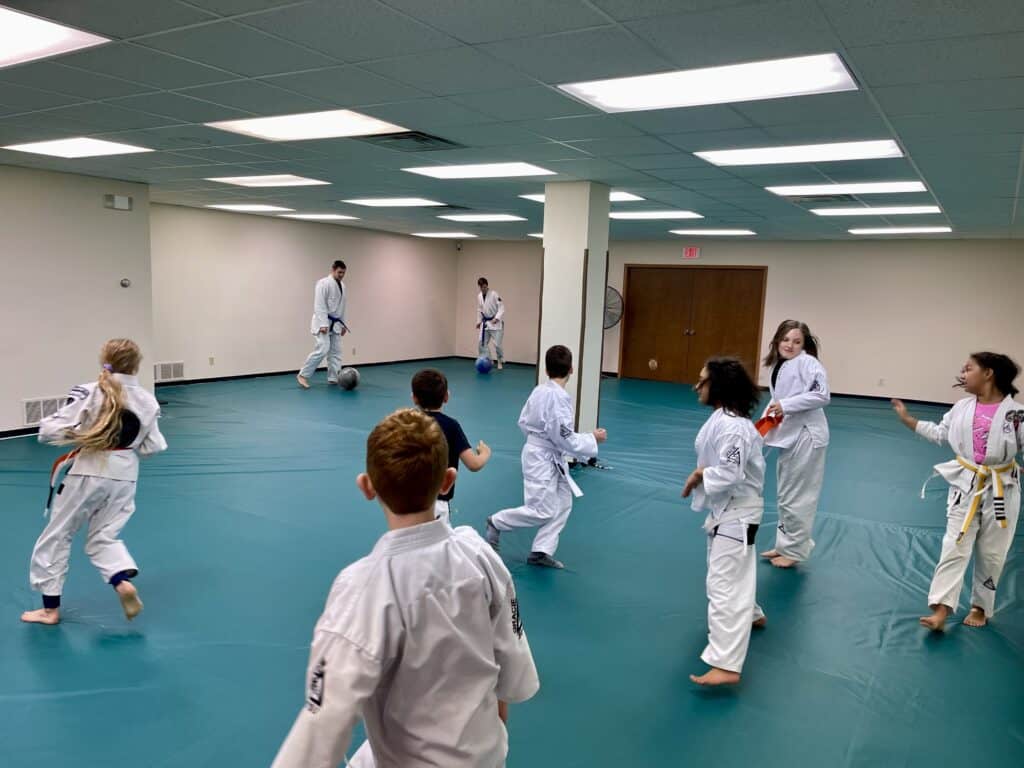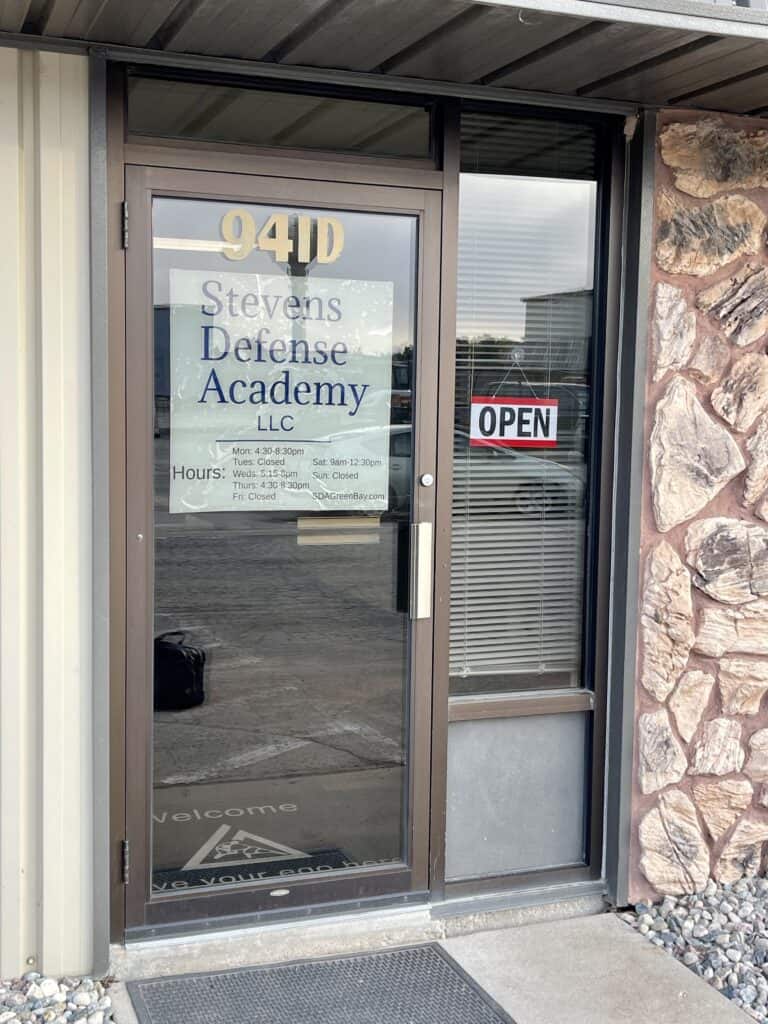
November 3, 2025
GREEN BAY – After operating on Green Bay’s west side for more than six years, Stevens Defense Academy has a new home at 941 Ashwaubenon St., Suite D.
Though the move was prompted by an unexpected rent spike, Co-owner Nate Stevens said he’s excited for what’s ahead.
With a week off from his day job serving as a law enforcement officer in Northeast Wisconsin, and thanks to the hard work of the academy’s small staff, Stevens said the relocation was completed with minimal disruption to classes.
“We set a goal to be reopened in 10 days, and we did it,” he said.
New location, teen classes
With the new location, Nate said he’s looking forward to imparting the wisdom, ability and confidence of Gracie Jiu-Jitsu for years to come.
Currently, he said the school has between 120-130 students – “about 40% women” – with ages ranging from five to, at one point, 77.
“The way we teach and the way we allow for more realistic movement without getting into that heavy, heavy grappling style really keeps injury rates way down, so we can have a much larger age range,” he said.
Nate said Stevens Defense Academy is also adding a new class specifically for 12- to 16-year-olds – yet another reason for enthusiasm for the new space.
“Our women’s program is just exploding by leaps and bounds, and I’m excited by all our programs,” he said. “We’ve got a much more professional-looking location, [too]… We’re excited, and we’re excited to see what the future brings for us.”
Focused on self-defense
When some people think of martial arts, they often picture swift strikes, powerful kicks and echoing shouts.
However, at Stevens Defense Academy, Nate said students are trained to minimize such confrontations rather than seek them out.
“Our general idea is obviously ‘avoid,’ if at all possible,” Nate said. “We talk about verbal de-escalation – getting out of the fight.”
Founded in early 2019 with his wife Tricia, Nate said the academy teaches Gracie Jiu-Jitsu®, “a form of Brazilian jiu-jitsu that’s focused entirely on self-defense” more so than scoring points or competing.
“We don’t do a lot of sports, but we keep everything aimed at what’s going to happen in a real fight,” he said.
Nate said he and Tricia, along with the academy’s other instructors – comprised of highly skilled martial artists, including some of the co-owners’ five children – teach what is known as “the gentle art” of jiu-jitsu.
Self-defense, -improvement
Per its website, sdagreenbay.com, Stevens Defense Academy offers a variety of tailored programs, including:
- Kids martial arts
- Self-defense
- Women’s self-defense
- Private training
- Reflex development
- Bullyproof Summer Camp
The “Little Champs” kids classes, Nate said, are for five- to seven-year-olds.
In those classes, he said “we mostly play games” as a fun yet effective way to introduce techniques to children.
Nate said another segment – “Junior Grapplers” – is suited for eight- to 10-year-olds.

These classes, he said, can progress into the academy’s co-ed self-defense program, which teaches Gracie Combatives® – a system of 36 core techniques developed from studies of real-world street fights.
From researching such altercations, Nate said a general pattern is revealed.
“The pattern is, in a street fight, two people get close, distance gets closed, a few strikes get exchanged, but very quickly you find one person grabbing hold of the other one, and almost always, then the entire system falls to the ground,” he said. “Usually, the bigger, heavier, stronger person is on top. That’s the pattern we see, so that’s where we go with it.”
Nate said Gracie Jiu-Jitsu teaches students to use “control, leverage and restraint” in holds, maneuvers and joint locks to nullify size and strength differentials.
“Very often, [assailants] end up giving you what you need to complete your technique on them,” he said. “We know a lot of what untrained people try to do – the distance they try to create, and the why, when and where – and that’s a lot of the stuff we teach.”
For example, Nate said in a one-on-one physical altercation, when most people square off, “they’re usually in that one arm’s-distance range.”
At Stevens Defense Academy, he said students are taught to maintain two arms’ distance, which requires an assailant to take a step closer, providing “an opportunity for us to either step out [or] back up and keep that distance.”
“Or, as [the attacker] comes and steps in, I’m going to come all the way and hug completely on as close as I possibly can get, because that diminishes those punches,” he said. “You cannot get a good, forceful punch if somebody is right up [close], if their ear is glued to your chest and their head is directly below your chin… Can they [hit]? Sure, but it’s not going to be nearly as powerful as if we’re in that street fight, one arm’s distance, wailing away at each other.”
As students develop such techniques, Stevens said they are awarded different colored bets to signify their level of mastery.
“Traditional for Brazilian jiu-jitsu is [a belt advancement order of] white, blue, purple, brown, black – but there are four stripes to each, and a stripe can take you quite a while to get,” he said. “At one point, I saw the average time for, say, a taekwondo or an American karate black belt could be between five and seven years. The average time for a Brazilian jiu-jitsu black belt can be 17-20 years.”
For kids at Stevens Defense Academy, Nate said the belt system is “a little different,” with belts awarded on a quicker timetable for encouragement – “they like to see that reward.”
Once students surpass combatives skills, he said they’re encouraged to not concern themselves with “chasing belts.”
“Just chase the knowledge,” he said. “Just learn what you’re going to learn that day. Make yourself better and walk out.”
Women Empowered
Nate said the academy’s emphasis on personal growth and conflict avoidance also extends to its women’s self-defense program, Women Empowered, which is taught by Tricia.
These classes, he said, likewise focus on research from real conflicts, particularly with size/strength discrepancies.
Nate said the training focuses on “realism” based on Tricia’s experience, as well as what he’s encountered on duty.
Compared to other training for women, which can focus on “groin strikes and eye gouges,” Nate said Women Empowered primarily promotes escape and, if necessary, restraint.
Particularly in a domestic setting, he said pre-emptively initiating violence can escalate a situation that likely could or should have been resolved.
“Take that situation to somebody who’s been in a relationship with somebody else for 10, 12, 14 years – they have genuine feelings and concern for this person – are you really going to take your thumb and drive it through their eye when they’re having a really bad day?” he said. “They totally went off the deep end…, but I don’t know many women who are really going to blind their loved one or seriously harm their loved one.”
As with all his students, Nate said de-escalation is the first and preferred response – whether dealing with loved ones or strangers.
Should that fail, he said the academy gives women “the tools to get yourself away from that wall they’re pushing you into and run, or to get yourself off the ground, or get them off of you and get up and run.”
“If necessary, we teach a lot of what we call ‘blood choke holds,’” he said. “If you cut off the blood supply to the brain for five to 10 seconds, the person goes to sleep… Render them unconscious for a few seconds, and then you can get out of Dodge. It truly ends up being ‘the gentle art,’ yet it’s realistic.”
Across programs, ages and genders, Nate said such realism is reinforced via video study and role-playing scenarios along with physical training.

More on Gracie Jiu-Jitsu
In the early 20th century, Nate said the Gracie family welcomed into their home a jiu-jitsu master who had emigrated from Japan to Brazil.
“Out of gratitude, he taught the entire [Gracie] family Japanese jiu-jitsu,” he said. “One of the sons of that family was a sickly little boy. He was watching; he knew he could not do the strength moves – they were doing a lot of strength-based moves in Japanese Jiu Jitsu – so in his mind, he began modifying it to be about leverage and timing.”
Nate said the other Gracie sons would soon adopt these techniques and become purveyors of this new Brazilian form of jiu-jitsu, ultimately introducing it to the United States.
As the martial art caught on, he said Carlos Gracie established Gracie Challenge matches in the 1920s.
These “no holds barred” competitions, which saw Gracie Jiu-Jitsu pitted against any mixture of martial arts techniques, Nate said, served as a precursor to the Ultimate Fighting Championship (UFC) mixed martial arts (MMA) company, co-founded by Rorion Gracie.
Though Gracie Jiu-Jitsu has a sport- and UFC-oriented side, Nate said at Stevens Defense Academy, the focus is on teaching restraint techniques aimed at preventing “undue damage.”
He said this could involve not only physical injury, but also potential assault or battery charges – or, for law enforcement officers like himself, the use of excessive force.
Between the real-world effectiveness of the techniques and the worldwide popularity of the UFC, Nate said the Gracies are “undoubtedly the most influential martial arts family in the world.”
Gracie Jiu-Jitsu, he said, has even influenced the U.S. Army, having become part of the curriculum for all five branches.
“I’m waiting to hear about it in Space Force, because jiu-jitsu in zero gravity would be completely awesome,” he laughed.
Visit Stevens Defense Academy’s website for more information.
 TitletownTech announces extension of expertise to Milwaukee
TitletownTech announces extension of expertise to Milwaukee Destination Door County featured in Destination Forward
Destination Door County featured in Destination Forward








